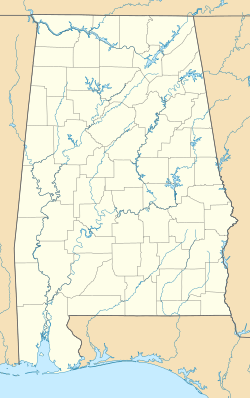Propulsion and Structural Test Facility facts for kids
|
Propulsion and Structural Test Facility
|
|

Propulsion and Structural Test Facility at the George C. Marshall Space Flight Center.
|
|
| Location | Marshall Space Flight Center, Huntsville, Alabama |
|---|---|
| Area | less than one acre |
| Built | 1957 |
| Architect | Heinz Hilten of the U.S. Army |
| NRHP reference No. | 85002804 |
Quick facts for kids Significant dates |
|
| Added to NRHP | October 3, 1985 |
| Designated NHL | October 3, 1985 |
The Propulsion and Structural Test Facility is a special place where huge rockets are tested. It's also known as Building 4572 or the Static Test Stand. This important facility is located at the Marshall Space Flight Center in Huntsville, Alabama. Built in 1957, it was the first place to test rockets with many engines all working together. Because of its big role in America's space journey, it became a National Historic Landmark in 1985.
What is the Test Facility?
Building 4572 is found in the East Test Area of the Marshall Space Flight Center. It's a very tall structure, made mostly of strong steel. It stands about 175 feet (53 meters) high. That's like a 17-story building!
The facility has a strong concrete base. This base helps it hold up the massive rockets. Nearby, there's another building, 4573. This building has a huge crane. The crane can lift very heavy things, up to 45 tons.
This test stand can be set up in different ways. It can test rockets that use solid fuel. It can also test rockets that use liquid fuel. These liquid-fueled rockets use things like liquid oxygen or kerosene. The facility can handle rockets up to 82 feet (25 meters) tall. It can also test rockets up to 22 feet (6.7 meters) wide.
A Place for Rocket History
This amazing facility was built in 1957. It was created by the Army Ballistic Missile Agency. This agency was in charge of making large rockets. The Propulsion and Structural Test Facility became the main center for testing these huge rockets.
Many famous rockets were developed here. The Saturn Family of rockets was tested at this site. This work was led by the famous rocket scientist Wernher von Braun.
One of the most powerful rockets ever built was the Saturn V. It was developed and tested right here. The Saturn V was the tallest, heaviest, and most powerful rocket. It was used to send astronauts to the Moon!
The facility was planned for updates in the 2010s. This was to get it ready for testing new types of rockets. It continues to be an important part of space exploration.



